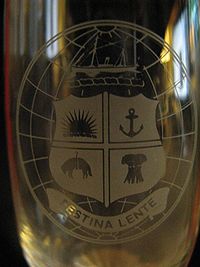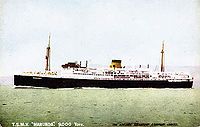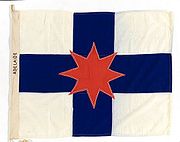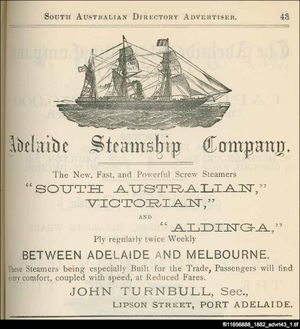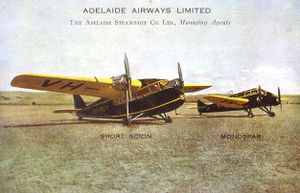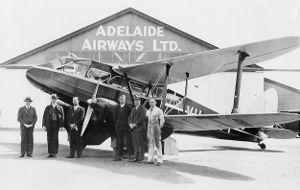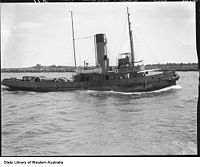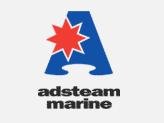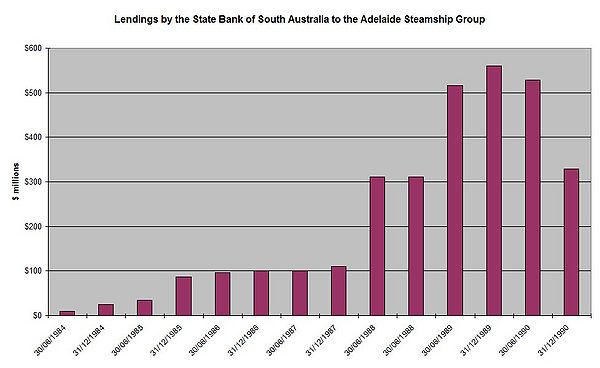Adelaide Steamship Company
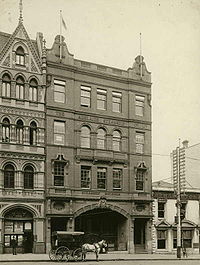
The Adelaide Steamship Company was formed by a group of South Australian businessmen in 1875. Their aim was to control the transport of goods between Adelaide and Melbourne and profit from the need for an efficient and comfortable passenger service.[2] For the first 100 years of its life, the main activities of the company were conventional shipping operations on the Australian coast, primary products, consumer cargoes and extensive passenger services.
In the 1930s and 1940s, the company diversified into the airline operations, towage, shipbuilding, and the shipping of salt, coal and sugar.[3] Adelaide Airways was formed in 1935, and purchased West Australian Airways before merging with Holyman's Airways to form Australian National Airways (ANA) in 1936. ANA was sold to Reg Ansett in 1957.[4]
In 1964, the Interstate fleet merged with McIlwraith, McEacharn & Co, and the partnership developed the world's first purpose built container ships.[4][5][6][7] However, in 1973, the company ceased its shipbuilding operations, and in 1977, in its 103rd year of operation, the company sold its shipping related businesses, and ceased its connection with ship owning and operating.[8] The company did, however, retain its interests in Tugboat operations.
In the 1970s and 1980s, with John Spalvins[9] at the helm, the company became a thriving and successful corporate raider with a very large and productive portfolio financed by huge borrowings. The recession of the early 1990s caused the nervous lenders, (over 200 banks), to demand the return of their assets.[10][11] This forced the liquidation of the porfolio, some of it at "fire-sale" prices, but most in a more orderly fashion via an "arrangement" with the creditor banks in order to avoid bankruptcy.[12][13][14]
With the completion of the liquidation, on 30 April 1997 the company was renamed to "Residual Assco Group Limited"[15] in order that the Adelaide Steamship name could be reused. Residual Assco was delisted on 24 December 1999 "at the entity's request".[4][16]
In June 1997, the Tug boat operations were floated on the Australian Stock Exchange under the name "AdSteam Marine".[4] In 2001, AdSteam Marine acquired its major rival, Howard Smith, making it the largest towage operator in Australia.[17]
In 2006, AdSteam Marine was acquired as the Pacific arm of the world's largest shipping company, AP Moeller-Maersk,[7][18] thus removing the Adelaide Steamship name from the Australian Stock Exchange and Australian Company registers.
Contents
Steamships
The Company was formed in September 1875 in Adelaide, South Australia, by a group of pastoralists and businessmen some whom already had steamship interests in the Spencer Gulf, namely Federal Wharf Co. Ltd, Port Adelaide Dredging Company Ltd and Spencer Gulf Shipping Co. Ltd, and was incorporated on 8 October 1875.[19]
Its promoters and founding directors included Andrew Tennant,[20] Robert Barr Smith[21] and Thomas Elder[22] of Elder Smith & Co Ltd. The first ship of the new company was the Flinders.[23] In July 1876 the company’s leading promoters amalgamated their private ship-owning interests to form the Spencer’s Gulf Steamship Co Ltd, trading in South Australian coastal waters. The two companies amalgamated in December 1882.[24] The fleet circled the coast from Derby in northern Western Australia to Cairns in northern Queensland.[23] Shipping operations were supported by a large network of agency offices in almost every major Australian port.[4]
During World War I, several Adelaide Steamship Company ships were requisitioned, as were several other privately owned ships; Grantala and Warilda as hospital ships and Wandilla and Willochra as troopships.[25] Yankalilla and Echunga were also commandeered.[23]
Adelaide Steamship Company was liquidated and reconstructed twice for more efficient and profitable operation, first in 1900 and subsequently in 1920.[19] On 20 January 1915 they took over Coast Steamships Limited, and kept it running as a subsidiary that retained its own identity until 1968.[8]
By the start of World War II, the company owned 30 ships.[8][25] With World War II, the company was again forced to surrender nine ships to the Navy, including the Manoora and Manunda which became an Armed Merchant Cruiser and a hospital ship. The Manunda was in Darwin harbour during the Japanese bombing and was able to bring 260 military and civilian casualties to safety in Fremantle.[25] In all during the war she carried about 30,000 sick and wounded back to Australia from the Middle East and New Guinea.[23] During the 1940s, a decline in trade necessitated the company to diversify and they began to acquire interests in other companies and projects. Consequently, after the war, the company diversified into towage, shipbuilding, and the shipping of salt, coal and sugar.[3][8]
On 1 January 1964, its interstate fleet was merged with that of McIlwraith McEacharn Ltd in a new company, Associated Steamships Ltd, in which Adelaide Steamship Company held 40%. Also in 1964, the merged company developed the world's first purpose built container ship, MV Kooringa.[4][26][27][28] Bulkships Ltd, in which Adelaide Steamship held a 40% interest in 1965, acquired all the shares in Associated Steamship Ltd in 1968. In 1977 the company’s interest in Bulkships was disposed of and Adelaide Steamship Company ceased its connection with ship owning and operating.[8] The company did, however, retain its interests in Tug boats and Tug boat operations and by the late 1980s, Adelaide Steamship was one of Australia’s oldest surviving industrial companies.[29]
Ships
Ships owned and operated by Adelaide Steamship Company included:
- Argosy Lemal, later Booya
- HMAS Bungaree
- SS Camira Built 1894 as SS Clan Campbell[30]
- SS Cantara Built 1894 as SS Clan Ross[30]
- SS Ceduna Built 1894 as SS Clan Mackay[30]
- SS Ferret
- MV Kooringa[6]
- SS Koombana[31]
- HMAS Manoora
- TSMV Manunda
- MV Minnipa[32]
- SS Paringa[32]
- Polly Woodside (1922-1953)
- SS Warilda, later HMAT Warilda[33]
- SS Willochra, later RMS Fort Victoria
- SS Yongala[34][35]
Aeroplanes
Adelaide Airways Ltd. was formed as a subsidiary of the Adelaide Steamship Co. Ltd. on 3 July 1935 and commenced operations on 29 October. It had a number of different types of aircraft in its fleet, including the Short Scion, the General Aircraft Monospar ST-25, and the De Havilland DH.89A.[36][37][38]
On 12 June 1936, Adelaide Airways purchased West Australian Airways for £25,000. Ivan Holyman (of Holyman's Airways Pty. Ltd.) approached AdSteam with a view to an amalgamation, aiming to form Australia's most powerful airline which would effectively control airline traffic between Perth, Adelaide, Melbourne and Sydney. On 12 June 1936 the two companies merged and, on 2 November 1936 with Orient Steam Navigation Company and Union Steam Ship Company of New Zealand, formed Australian National Airways Pty. Ltd. (ANA), "the pre- and post-war giant among Australian domestic airlines".[4][37] AdSteam retained partial ownership in ANA until Holyman's death in 1957. The ANA board then unsuccessfully attempted to sell out to the Government owned Trans Australia Airlines (TAA), before reaching agreement with Reg Ansett to sell the airline to him for £3.3 million. ANA and Ansett Airways were merged to form Ansett-ANA on 3 October 1957.
Shipbuilding
Adelaide Ship Construction Ltd was set up as a subsidiary of the Adelaide Steamship Company in 1957, and was incorporated in July 1957. At the same time it was issued with the sole Australian licence for the Hydroconic hull design patented by Burness, Corlett & Partners, United Kingdom. This hull design for tugs gave them greater bollard pull from a given horsepower. Adelaide Ship Construction had been set up especially to address the issue of Australia's ageing fleet of tugs. The yard was built on the historic Fletcher's slip site at Birkenhead.[39]
The keel for the first tug was laid 20 May 1958 and it was launched 12 February 1959. The shipyard site grew from two acres and one berth to four berths and 6½ acres in 1968, and to cater for vessels up to 425 feet long. At this time it employed more than 1000 men. Adelaide Ship Construction had also acquired from Burness, Corlett and Partners the licence for their 'Towmaster' patent. Coupled with the Hydroconic hull design this enabled ever greater pull in its tugs. Hamersley Comet, built in 1968 had a bollard pull of 34.1 tons, the strongest to that time.[39]
However, by 1973 the yard was running at a loss of $3.4 million, and it was officially closed in August of that year. Its last ship was Cape York.[39]
Tug boat operations
A relatively minor sideline, started in the 1890s, was the company's tug boat operations. Gradually, tug boat operations extended over a number of ports, but until the middle of the 20th century they remained the poor relation of the more significant coastal shipping operations. With the decline of coastal shipping however, towage assumed more importance. By the 1960s, towage and associated operations represented a very significant part of the company's activities.[4]
In 1977 the company’s interest in Bulkships Ltd. was disposed of, and Adelaide Steamship Co Ltd ceased its connection with ship owning and operating. It had diversified into investment and property ownership, vineyard and wine production, optical goods manufacturing and distribution, engineering, share investment, and, until 1973, shipbuilding. Thus towage and associated operations continued to have prominence, even during the 1970s and 1980s when The Adelaide Steamship Company became the foundation for one the country's major conglomerate organisations.[4]
As this activity was happening, towage began to reassert itself as an important element of the company; during this period of aggressive growth, AdSteam had 156 tug boats and operated in over 40 Australian, Indian, Pacific Oceana and British ports.[17] Strengthened by a series of industry rationalisations - Brambles' Port Kembla, Sydney and Newcastle operations and P&O's towage operations in Western Australia - the towage division became a valuable candidate for asset disposal. In April 1997 the company changed its name to Residual Assco Group Ltd and in June 1997 floated its marine division which was registered on the Australian Stock Exchange as Adsteam Marine Ltd.[4]
Once it became a publicly listed company in its own right, Adsteam Marine established a strong investor following. In addition to towage, the company developed shipping agency and tug barging activities. Adsteam Marine Limited doubled its size in May 2001 when it acquired the towage interests of Howard Smith, its partner in many towage ventures, for more than AU$500 million (US$246 million), making it the largest towage operator in Australia.[17]
In 2006, it was acquired as the Pacific arm of the world's largest shipping company, AP Moeller-Maersk.[4][7]
The Corporate Raider
After becoming chief executive of the Adelaide Steamship Company in 1977, John Spalvins built up one of Australia's largest industrial conglomerates and became one of the most feared takeover specialist in corporate Australia.[9][40][41] Spalvins transformed himself into an entrepreneur, using vast amounts of debt to launch a series of massive takeovers.[42] Adsteam "aggressively acquired significant shareholdings in a variety of companies in a number of fields including retailing, hotels, leisure industries and civil engineering."[29] "Adsteam’s share price rose dramatically through much of the 1980s and it was hailed by some commentators as being entrepreneurial, well managed and with a highly disciplined reporting system."[43]
At its height, the Adsteam group included Woolworths, David Jones, brewer Tooth and Company, the Petersville Sleigh food group, the "Farmer's Union" dairy group, Metro Meat, a stable of premium wineries and many others.[41][44][45][46] Also, at various stages, it held a 15% stake in Westpac,[40] a 20% stake in Bell Resources Ltd,[47] and numerous other "strategic" stakes and investments. During this period of aggressive growth, AdSteam also had 156 tug boats and operated in over 40 Australian, Indian, Pacific Ocean and British ports.[17] The company was Australia's fourth highest capitalised company during the 1980s.[4]
Group structure
A characteristic of the AdSteam Group during this period was a complex Group Structure of cross-ownership where many of the companies of the group owned not-quite-50% of each other.[29] This served the dual purposes of making the elements of the group "take-over proof", but did not trigger the financial reporting requirements of a consolidated set of accounts. In the 1990 Adelaide Steamship Company Annual Report, the following companies were reported as "Principal operating subsidiaries" of the AdSteam Group, with the following cross ownerships greater than 5%:[48]
- The Adelaide Steamship Company
- 100% Marine Interests (various)
- 100% Martin Wells Holdings Ltd - Optical Goods - acquired 1982.[49]
- 100% Sellers Atkins Ltd - Building Supplies - acquired 1976.[50]
- 100% Pioneer Property Group Ltd – House Building & Property Development[51]
- 100% WA Realty Pty Ltd - Real Estate
- 49% David Jones Limited - Department stores and investments
- 50% Metro Meat (Holdings) Ltd - Meat
- 14% Tooth and Co. - (Brewing,) Hotels, Investments, Wine, Food - Acquired 1981. Brewing interests sold 1983 to Carlton and United Breweries.
- 18% Petersville Sleigh Ltd - Food, Timber, Woodchips, Mining, Distribution of Earthmoving Equipment, Shipping Agencies, Investments - Food product manufacture, distribution and marketing (sold to Pacific Dunlop).
- 13% National Consolidated Ltd - Diversified Manufacturing and Marketing, Investments[52]
- 33% Industrial Equity Ltd[53] Food and Beverages, Energy and Resources, Manufacturing and Distribution, Propertey Services, Investments
- 18% AWA Ltd - Manufacturing & Instalation of Electronics & Electrical Communications products
- 23% Macmahon Holdings Ltd - Civil Engineering, Leisure Industries
- 48% Markheath Securities PLC - Property Development, Manufacturing, Investment
- 100% John Martin & Co. - Department stores - Acquired 1985
- John Martin Financial Services Limited
- John Martin Retailers Limited
- 44% The Adelaide Steamship Company
- 44% Tooth & Co Ltd - Hotels, Investments, Wine, Food
- 30% AAM Inc - Coal Handling, Office Supplies, Investments
- 33% Industrial Equity Ltd[53] Food and Beverages, Energy and Resources, Manufacturing and Distribution, Propertey Services, Investments
- 50% Metro Meat (Holdings) Ltd - Meat
- 33% Industrial Equity Ltd[53] Food and Beverages, Energy and Resources, Manufacturing and Distribution, Propertey Services, Investments
- 18% National Consolidated Ltd - Diversified Manufacturing and Marketing, Investments
- 30% AAM Inc - Coal Handling, Office Supplies, Investments
- 51% Howard Smith Ltd - Shipping, Distribution, Heavy Engineering, Investments
- National Consolidated Limited
- 20% David Jones Limited - Department stores and investments
- 10% Markheath Securities PLC - Property Development, Manufacturing, Investment
- Howard Smith Ltd
- 7% Markheath Securities PLC
- Industrial Equity Limited (IEL)
- 100% Woolworths Ltd[53] - Retail
Other companies, acquisitions and disposals
Other companies, acquisitions and disposals in the group included:
- Lockwood locks[54]
- Buffum's - chain of Long Beach, California based department stores
- Wineries, including Penfolds, Wynns Coonawarra Estate, Seaview, Glenloth, Kaiser Stuhl, Barossa Co-op, Tulloch and Loxton Co-op, sold to SA Brewing holdings in 1990.[44] Other wineries owned by group members at one time or another included Seppelts and Woodley Wines (IEL).[55]
- Bridgestone
- Farmer's Union - subsequently floated as part of National Foods
- SAFCOL Food Processing - sold to Tropical Canning (Thailand) PLC[56]
- Vaniro - for some reason not explained, Vaniro is not included in the 1990 Annual Report Group Structure diagram. It does, however, feature significantly in the State Bank audit report.[55]
- Dextran Pty Ltd - like Vaniro, another AdSteam subsidiary.[56] Dextran is the owner of IEL.[57]
During the 1980s, AdSteam instigated a number of "Share plays",[55] and also made significant investments in a number of companies including:
- ANZ Bank
- BHP
- Bell Resources
- Royal Insurance PLC
- National Australia Bank
- Westpac Bank
Borrowings
All of this was financed by huge borrowings from about 200 banks. For example, the lendings of just one bank, the State Bank of South Australia, are summarised in the following chart.[55]
The source of the above data, (SA Govt Auditor in 1993), in a comment dated 26 April 1990, states: "Papers also comment on "off the record" discussions with Adsteam Group's major bankers and gives exposures of nine banks (including the Bank) which total $4,960M. There is little comment on this figure but an analysis of each company's results shows assets exceed liabilities in each company by a good margin." A second comment states: 'Paper also comments on recent press issues including potential worst case losses of $110.0M from Bell Resources investment - "the impact of such a loss ..... is not considered a major concern" ' [55]
A subsequent comment dated 26 July 1990 states: 'Lending Credit Committee minute notes planned reduction in exposure through maturity of facilities. Also notes extension of other facilities to August 1991 which illustrates "the continued level of confidence this Bank held in Adsteam's continuity".[55] With the benefit of hindsight, further comments make interesting reading. It is also interesting to note that despite the assurances recorded in the board papers, from that point in time the State Bank of South Australia steadily reduced its exposure to the AdSteam Group.
1990-1991
The opaque nature of the AdSteam Group caused rising concern in a variety of circles. Although shareholders continued to enjoy bonus shares, rights issues, and significant dividends, the share price plateaued. Financial journalists started asking questions, and the share price faultered. After the 1990 AGM and the announcement of the 25c dividend (per share) against a diminished share price, investor confidence deserted the company and the share price crashed from over $5 to under $1 in one day.
The previously "nervous" banks were far from happy, and started demanding the return of their capital. Of course, AdSteam had this money invested, and did not have billions of dollars of liquid assets. Also of course, the banks were not keen to force AdSteam into bankruptcy as such a situation would be unlikely to achieve the return of their assets. Hence, AdSteam organised an "arrangement" with the 200 banks, and in 1991 the Adsteam group was placed under an informal, receivership-type scheme of arrangement.[29][58] Under this arrangement, there was an orderly disposal of assets.
The aftermath
In order to facilitate the orderly disposal of assets, a number of the group members were renamed:
- The Adelaide Steamship Company[15] became The Residual Assco Group[16]
- David Jones Limited[59] became DJL Ltd[60]
- Metro Meat Holdings became Ortem Holdings[61][62]
During the course of the disposal, there were a number of sales, and four very successful floats:
- National Foods (1991)
- Woolworths Limited[53] (1993)
- David Jones Limited (1995) and
- AdSteam Marine (1997)[18]
Never-the-less, not all of the disposals were made under ideal circumstances, and Adsteam's loss of $4.49 billion represented one of Australia's largest corporate collapses.[63][64]
However, the major lesson out of the AdSteam collapse was for the accounting profession; a newspaper report on its failure carried the sub-headline “Adsteam a humiliation for the accounting profession”.[29][65][66] "Adsteam was “an excellent instance of how the rule-book approach to consolidation accounting imposed by the law and the Accounting Standards at the time determined managerial actions” ".[43]
The "Adsteam saga" resulted in major changes to Australian accounting rules pertaining to consolidation and led to the issue of AAS 24 Consolidated Financial Statements by the accounting profession in June 1990 for application from 30 June 1991 (subject to a “legal impediment”, see Deegan, 2005, p. 880[67]) and the issue of AASB 1024 Consolidated Accounts with statutory backing in 1991[68][69]
Specifically, the definition of “control” for consolidation purposes was broadened beyond prescribed ownership interests to embrace control over an entity’s financial and operating policies, making use of the notion of “substance over form” in determining the existence of a controlled entity.[29]
The "AdSteam saga" also provided some lessons for banks and auditors. For example, the SA Govt Auditor produced a number of Case Studies - Volume 6 is titled "The Management of Credit: Case Studies", and Chapter 9 is titled "Case Study in Credit Management: The AdSteam Group". The opening sentence states: "The exposure to the Adelaide Steamship Company Limited Group of Companies was complex.", and if your interests lie in those directions, makes fascinating reading.[70]
Industrial Equity Ltd
Several matters from the collapse are still ongoing - over 15 years after "the collapse". Industrial Equity Ltd (IEL) is worthy of particular mention:[11][55][71][72]
- IEL acquired Woolworths Limited in 1989 as a wholly owned subsidiary
- AdSteam investment company Dextran purchased IEL from Brierley Investments Ltd (BIL) in November 1989
- Dextran was one-third each owned by AdSteam, David Jones & Tooth[57]
- IEL delisted in 1990.[72]
- Woolworths floated in 1993 - very successfully - "it was floated in the biggest share sale (at that time) in Australia's history"
- The Australian Taxation Office (ATO) ruled to disallow IEL $524m of deductions
- IEL challenged this ruling - the matter has been before the courts on and off ever since - "One of the largest and longest tax disputes in Australian history."[11]
- In December 2007, IEL was given leave to challenge the ATO ruling
- "While prime assets such as Woolworths and Adsteam Marine were floated, IEL and its tax liabilities remained within the corporate shell of Adelaide Steamship when it was renamed Residual Assco Group Ltd in 1997 and delisted in 1999. Residual Assco has no operating businesses but remains active while several IEL tax disputes wind their way through the courts."[11]
- Residual Assco's October 2007 annual report notes that the group holds $429 million "on deposit pending resolution of the outstanding matters between IEL and the ATO". At that time, the ATO were claiming $7.3 billion.
- The dispute continues; the Chairman's address to the concurrent AGMs of Residual Assco, DJL and Tooth on 14 November 2008 is rather bleak.[73] The Tooth & Co. Ltd. Annual Financial Report to 30 June 2008 summarises the then current situation in detail.[74]
- Other sources of information include: "The Three Ugly Sisters", Australian Financial Review, 24 December 1999 and Tooth and Co.#The three ugly sisters.
Court cases
The Adelaide Steamship Company was involed in two court cases which led to changes in the way the Australian Constitution and Australian Law is interpreted.
The "Engineers' Case"
"Amalgamated Society of Engineers v Adelaide Steamship Co. Ltd. (1920) 28 CLR 129" (commonly known as the Engineers' Case) was a landmark Australian court case decided in the High Court of Australia on 31 August 1920.[75] From a legal perspective, this case is widely regarded as one of the most important cases ever decided by the High Court of Australia, for it swept away the earlier doctrines of implied intergovernmental immunities and reserved State powers, firmly establishing the modern basis for the legal understanding of federalism in Australia and Australian constitutional law.[76] In essence, this meant that decisions of the Commonwealth Conciliation and Arbitration Court were binding on State governments.[77] and that the constitution is no longer read in a way which attempts to preserve the power of the states.
When providing his judgement on Strickland v Rocla Concrete Pipes Ltd, (where the Court unanimously rejected the decision in Huddart, Parker & Co Pty Ltd v Moorehead, holding that it was based on the rejected doctrine of reserved State powers, which was abolished in Amalgamated Society of Engineers v Adelaide Steamship Co. Ltd.), Justice Barwick stated "the earlier doctrine virtually reversed the Constitution".
ASIC vs former AdSteam directors and auditors
"Residual Assco and Australian Securities and Investments Commission (ASIC) vs former AdSteam directors and auditors.[78]
- The litigation was commenced by ASIC in April 1994 under section 50 of the ASC Law, in the name of the Adelaide Steamship Company (renamed Residual Assco. in 1997) and dragged on, unresolved, for 6 years before a settlement was agreed.
- The essential allegation was that there had been an overstatement of profit in the company's accounts and that its investments in 4 subsidiary companies had not been accurately recorded. As a result dividends had not been paid out of profits.
- The terms of settlement provide for some unique and important regulatory outcomes, including:
- In May 1994 proceedings were brought by Deloitte under the Administrative Decisions (Judicial Review) Act challenging ASIC's decision to begin and carry on the Adsteam proceedings. The ADJR proceedings took approximately two and a half years to be finally determined. ASIC's decision was ultimately upheld.
- "The Adelaide Steamship Co Limited and Australian Securities and Investments Commission v Janis Gunars Spalvins, Michael James Kent, Neil Leslie Branford, Kenneth William Russell, Michael Stevenson Gregg, Deloitte Haskings & Sells and Deloitte Ross Tohmatsu", more concisely referred to as "Adelaide Steamship Co Ltd v Spalvins (1998) 152 ALR 418"[79][80] This was in fact an appeal by Spalvins et al. against an earlier ruling in favour of ASIC regarding client legal privilege. The appeal was upheld and ASIC were required to produce the documents previously ruled as privileged.
- In June 1999 the High Court held that the constitution did not allow State judicial power to be vested in the Federal Court (Re Wakim). As a result, the Adsteam proceedings, which had been brought in the Federal Court, could not proceed because the Federal Court did not have jurisdiction to hear them.
- Following the introduction of the Federal Courts (State Jurisdiction) Act (SA) 1999, which was intended to address some of the effects of the decision in Re Wakim, an application was made in the Supreme Court of South Australia effectively to have the Adsteam proceeding transferred to that Court. The validity of the relevant provisions of the Federal Courts (State Jurisdiction) Act was challenged by some of the defendant directors. On 25 May 2000 the High Court upheld the validity of section 11 of that Act. (The application to have the matter transferred was still pending before the Supreme Court of South Australia at the time of the settlement.)
Timeline
- 1875 Company formed September 1875
- 1875 Company incorporated 8 October 1875
- 1882 Amalgamated with Spencer's Gulf Steamship Co. Ltd.
- 1882 Bought out William Whinham.[23]
- 1883 Bought out Anderson & Marshall[23]
- 1887 Locks out members of the Captains & Officers' Society when it seeks to affiliate with the Maritime Labour Council[81]
- 1900 Liquidated and reconstructed
- 1903 Adelaide building at 17 Currie Street (Images: 1234)
- 1904 Adelaide Steamship Company building constructed in Melbourne
- 1911 SS Yongala lost without trace (discovered in 1958)
- 1914-1918 World War I - several ships were requisitioned
- 1915 Took over Coast Steamships Limited
- 1920 Liquidated and reconstructed
- 1920 "Amalgamated Society of Engineers v Adelaide Steamship Co. Ltd." (The Engineers' Case)
- 1933 First John Martin's Christmas Pageant
- 1935 Formed Adelaide Airways Ltd.
- 1936 Purchased West Australian Airways
- 1936 Merged with Holyman's Airways Pty. Ltd. to form Australian National Airways Pty. Ltd. (ANA)
- 1939 Currie St (Adelaide) building changed significantly (Images: 12)
- 1939-1945 World War II - several ships were requisitioned
- 1940s Diversified into towage, shipbuilding, and the shipping of salt, coal and sugar.
- 1957 Sold Australian National Airways Pty. Ltd. to Reg Ansett
- 1964 Interstate fleet merged with McIlwraith McEacharn Ltd to form Associated Steamships Ltd
- 1964 The world’s first purpose-built container ship was constructed.
- 1965 Acquired 40% interest in Bulkships Ltd
- 1968 Coast Steamships Limited no longer "retained its own identity"
- 1968 Bulkships Ltd acquired Associated Steamship Ltd
- 1976 Tooth & Co acquired Penfolds
- 1977 Bulkships Ltd sold; ceased connection with ship owning and operating
- 1980 Acquired a substantial interest in David Jones Limited
- 1980 Adelaide Steamship Company building in Melbourne destroyed
- 1981 Acquired Tooth & Co (via David Jones (Properties) Pty Ltd)
- 1981 Acquired Georges (via David Jones)
- 1982 Acquired Buckley & Nunn (via David Jones)
- 1983 Sold Tooth & Co brewing interests to Carlton and United Breweries
- 1985 Acquired John Martins
- 1989 Industrial Equity Ltd (IEL) purchased from Brierley Investments Ltd (BIL)
- 1990 Wine interests sold to SA Brewing Holdings
- 1990 Share price crash
- 1991 AdSteam commenced liquidation of assets
- 1991 National Foods floated
- 1993 Woolworths floated
- 1994 The Australian Taxation Office (ATO) ruled to disallow IEL $524m of deductions regarding the Woolworth float
- 1994 "Adelaide Steamship Company (via ASIC) vs former AdSteam directors and auditors" commenced
- 1995 David Jones floated
- 1997 Adelaide Steamship Company renamed to Residual Assco Group
- 1997 AdSteam Marine floated
- 1999 Liquidation of assets completed - Residual Assco Ltd delisted - "Residual Assco has no operating businesses but remains active while several IEL tax disputes wind their way through the courts."
- 2000 "Residual Assco (via ASIC) vs former AdSteam directors and auditors" reached settlement
- 2001 AdSteam Marine acquired Howard Smith for AU$500m
- 2006 AdSteam Marine acquired by AP Moeller-Maersk
- 2007 Residual Assco's annual report notes that the group holds $429 million "on deposit pending resolution of the outstanding matters between IEL and the ATO"
- 2007 IEL given leave to challenge the ATO ruling
People
Throughout its history, many people have been involved with, played significant roles in and/or been associated with the company:
- Robert Barr Smith (1824-1915) - Founding director. Brother-in-law of founding director Sir Thomas Elder, with whom he was partner in Elder Smith and Company. (Barr Smith married Elder's sister Joanna).[21]
- Tom Elder Barr Smith (1863-1941) - director (eldest son of Robert Barr Smith)[82]
- Sir Tom Elder Barr Smith (1904-1968) - director and deputy chairman (1960-1968) (son of Tom Elder Barr Smith)[83]
- William Beardmore, 1st Baron Invernairn (1856-1936) - shipbuilder.
- William Berry (1857-1928) - completed his qualifying sea service with the company and went on to become their chief engineer.[84]
- Neil Leslie Branford - Chief Accountant of John Martins, AdSteam Company Secretary from mid 1980s to early 1990s[78][79][80]
- Sir Ron Brierley - New Zealand investor, corporate raider, and chairman and director of a number of companies in Australia, New Zealand and the UK. He founded Brierley Investments Limited (BIL) in 1961 and purchased his first shareholdings in Industrial Equity Limited (IEL) in 1964. IEL purchased Woolworths in 1989, and later in 1989 Brierly sold IEL to the AdSteam Group.
- George Calder (1839-1903) - mariner[85]
- David Charleston (1848-1934) - a marine engineer and unionist who worked for the company after migrating to Australia in 1884.[86]
- Bruce Corlett - Chairman of Adsteam Marine Limited.
- Charles D'Ebro (1850-1920) - Architect who in 1904 designed the Adelaide Steamship Building in Melbourne.
- Frank Duffy (1852-1936) - High Court Judge involved in the decision of the Engineers' Case.[87]
- Sir Walter Gordon Duncan (1885-1963) - Director between 1932 and 1960.[88]
- Don Dunstan's father - Manager of the company's Fiji office from 1916 until the family's more to Adelaide in 1933.[89]
- Sir Thomas Elder (1818-1897) - Founding director. Brother-in-law of founding director Robert Barr Smith, with whom he was partner in Elder Smith and Company. Elder never married, but Barr Smith named his first-born Tom Elder Barr Smith.[22]
- Alexander Forrest (1849-1901) - negotiated in 1893 the contract with the Adelaide Steamship for serving Western Australian ports.[90]
- James Gosse (1876-1952) - director and chairman.[91]
- Robert Holmes à Court - Australia's first billionaire was also a feared corporate raider of the 1980s who set up Bell Resources, a company 20% owned by the AdSteam Group.[47]
- Sir Ivan Nello Holyman (1896-1957) - merged Holymany's Airways with AdSteam's Adelaide Airways in 1936, and initiated moves which led in November 1936 to the formation of Australian National Airways.[92]
- Henry Keep (1863-1905) - shipping agent for AdSteam in Fremantle between 1893-1897.
- Herbert Lloyd (1883-1957) - board-member of several companies, including the Adelaide Steamship Co. Ltd between, 1946 and his retirement.[93]
- George R L Macdonald - company secretary (1990-1994) and corporate lawyer[94]
- Malcolm McEacharn (1852-1910) - shipowner and partner of McIlwraith, McEacharn & Co which merged with the Adelaide Steamship Co in 1964.[95]
- Andrew McIlwraith (1844-1932) - shipowner and partner of McIlwraith, McEacharn & Co which merged with the Adelaide Steamship Co in 1964.[96]
- Hugo Muecke (1842-1929) - Director of many companies, including the Adelaide Steamship.[97]
- Guy Packard (1884-1963) - Manager and later Director. Also had financial interests in Australian National Airways.[98]
- Daniel Poole DCM & Bar (1882-1959) - recommended for the VC during World War I. Worked for both McIlwraith, McEacharn & Co and Adelaide Steamship Company.[99]
- Robert Dalrymple Ross (1827-1887) - Chairman of the company during the 1870s and 1880s.[100]
- David J Ryan - held various senior positions in the company from 1997 to 2002, and was the foundation Managing Director of Adsteam Marine Limited.[101]
- Charles Seymour (1853 - 1924) - Seaman, journalist and militant unionist who worked for the company in the late 1800s.[102]
- John Spalvins (Janis Gunars Spalvins) - Managing Director (1977-1990)[9][78][79][80]
- Andrew Tennant (1835-1913) - founding director.[20]
- Robert Wright - executive director 1991 to 1995[103]
See also
References and notes
- ↑ The Adelaide Steamship Company building in Melbourne, Victoria, Australia was designed in the Palazzo style in 1904 by London-born architect Charles D'Ebro (1850-1920). It was destroyed in 1980.
- ↑ Bach, John (1976). A maritime history of Australia. Published by Thomas Nelson (Australia). OCLC 3772111. ISBN 0170050874.
- ↑ 3.0 3.1 Adelaide Steamship Co Ltd building, Cairns (2006). Queensland Heritage Register, Environment Protection Agency, Department of Environment & Resource Management, Queensland Government. Retrieved on 11 July 2009.
- ↑ 4.00 4.01 4.02 4.03 4.04 4.05 4.06 4.07 4.08 4.09 4.10 4.11 The Adelaide Steamship Company history (2008). Shipping Line Histories: The Ocean Liner Virtual Museum. oceanlinermuseum.co.uk Retrieved on 6 July 2009.
- ↑ The Adelaide Steamship Coy Ltd, Steamship buildings (2009). Picture Australia. Retrieved on 23 June 2009.
- ↑ 6.0 6.1 Made in Australia – Global Solutions From Down Under. (2005). Australia's Official World Expo Business Publication. Retrieved on 23 June 2009.
- ↑ 7.0 7.1 7.2 Hopkins, Phillip (2006). Adsteam shares make waves after great Dane's $693m takeover bid. 4 July 2006, The Age: Business. Retrieved on 23 June 2009.
- ↑ 8.0 8.1 8.2 8.3 8.4 Adelaide Steamship Co. (2007). The Ships List. Retrieved on 23 June 2009.
- ↑ 9.0 9.1 9.2 Clarke et al. (2003) Corporate Collapse, pg.xiii
- ↑ Macfarlane, Ian (2006). The real reasons why it was the 1990s recession we had to have. 9 December 2006. The Age: Business. Retrieved on 26 June 2009. (Ian Macfarlane was Governor of the Reserve Bank of Australia (RBA), Australia's central bank, from 1996 to 17 September 2006.)
- ↑ 11.0 11.1 11.2 11.3 Sexton, Elisabeth (2007). Fresh twist in IEL's monster tax case. 28 December 2007. Brisbane Times Online. Retrieved on 27 June 2009.
- ↑ Fleming, Grant (2004, p. 184). The big end of town. Cambridge University Press, New York. OCLC 69671832. ISBN 0511185065.
- ↑ Gettler, Leon (2004). Ex-Spalvins company forced to take $234m tax bill on board. The Sydney Morning Herald. Retrieved on 25 June 2009.
- ↑ Randall, Jeff (2005). Wizards from Oz could fall as flat as Eddie the Eagle. Telegraph Online. Retrieved on 27 July 2009.
- ↑ 15.0 15.1 The Adelaide Steamship Company Limited (AST), 30 April 1997, Delisted Australian companies, delisted.com.au. Retrieved on 12 July 2009.
- ↑ 16.0 16.1 Residual Assco Group Limited (RAG), 24 December 1999, Delisted Australian companies, delisted.com.au. Retrieved on 12 July 2009.
A subsequent entry dated 3 April 2007 states: "company is an unlisted public company awaiting resolution of outstanding tax issues - it may then be wound up - shareholders are unlikely to receive any return but they can contact the company on 02 9258 8833 or Registries Ltd on 02 9290 9600". - ↑ 17.0 17.1 17.2 17.3 Gaston, Jack & Ware, Hugh (2001). One World, One Tug Company? Marcon International, Inc. Retrieved on 25 June 2009.
- ↑ 18.0 18.1 AdSteam Marine (ADZ) delisted.com.au Retrieved on 22 July 2009. "Delisted following compulsory acquisition by Svitzer Australasia Services Pty Limited 17/5/2007."
- ↑ 19.0 19.1 Adelaide Steamship Company Ltd (1875 - 1997) (2006). Guide to Australian Business Records. Retrieved on 25 June 2009.
- ↑ 20.0 20.1 Combe, Gordon D (1976). 'Tennant, Andrew (1835-1913)'. Australian Dictionary of Biography, Volume 6, Melbourne University Press, pp 255-256. Retrieved on 9 July 2009.
- ↑ 21.0 21.1 van Dissel, Dirk (1976). 'Smith, Robert Barr (1824-1915)'. Australian Dictionary of Biography, Volume 6, Melbourne University Press, pp 153-154. Retrieved on 9 July 2009.
- ↑ 22.0 22.1 Gosse, Fayette. (1972) 'Elder, Sir Thomas (1818-1897)', Australian Dictionary of Biography, Volume 4, Melbourne University Press, pp 133-134. Retrieved on 11 July 2009.
- ↑ 23.0 23.1 23.2 23.3 23.4 23.5 SA Memory (2008). South Australian shipping lines: Adelaide Steamship Company: Beginnings, Expansion, Cutbacks and containerisation State Library of South Australia, Government of South Australia. Retrieved on 8 July 2009.
- ↑ Hoskin, John (2008). Adelaide Steamship Company Ltd. Flotilla Australia. Retrieved on 25 June 2009.
- ↑ 25.0 25.1 25.2 Wylie, Ron (2006). The Australian Merchant Navy: Adelaide Steamship. Retrieved on 30 June 2009.
- ↑ Technology in Australia 1788-1988 (2000). Australian Science and Technology Heritage Centre. Retrieved on 2 July 2009.
- ↑ Our History: April 1964 (2009). Fremantle Ports, Western Australia. Retrieved on 2 July 2009.
- ↑ Rhiannon, Lee (2000). World Maritime Day. Hansard: Parliament of New South Wales. Retrieved 2 July 2009.
- ↑ 29.0 29.1 29.2 29.3 29.4 29.5 Carnegie, G and O'Connell, B. (2005). Accounting scandals in Australia since the late 1980s. University of Ballarat and James Cook University. Retrieved on 11 July 2009.
- ↑ 30.0 30.1 30.2 These three ships were purchased from the Clan Line in 1914.
- ↑ SS Koombana, Shipwrecks, WA Museum. Retrieved on 24 June 2009.
- ↑ 32.0 32.1 Larsson, Björn (2008). Adelaide Steamship Co. Sailings c. Late 1920s, Images: MV Minnipa and SS Paringa Maritime Timetable Images. Retrieved on 8 July 2009.
- ↑ HMAT Warilda, Memorial to Edward (Hughie) Dodd. Retrieved on 24 June 2009.
- ↑ SS Yongala (2009). Townsville Maritime Museum. Retrieved on 6 July 2009.
- ↑ The Yongala Story, Heritage Centre Education Kit, Sheet 6, Issue 2, April 2006, pp.3-4. Retrieved on 19 July 2009.
- ↑ Adelaide Airways postcard, 1935, The Airways Museum & Civil Aviation Historical Society. Retrieved on 30 June 2009.
- ↑ 37.0 37.1 Adelaide Airways DH89A VH-UVT, 1936, The Airways Museum & Civil Aviation Historical Society. Retrieved on 30 June 2009.
- ↑ Adelaide Airways Ltd (1935 - 1936), Guide to Australian Business Records. Retrieved on 30 June 2009.
- ↑ 39.0 39.1 39.2 SA Memory (2009). Adelaide Ship Construction Ltd, Shipbuilding in South Australia: Twentieth century, State Library of South Australia, Government of South Australia. Retrieved on 14 July 2009.
- ↑ 40.0 40.1 Porter, Ian (2006). Tyresome approach has Spalvins trying to tread on board. The Age: Business. Retrieved on 27 June 2009.
- ↑ 41.0 41.1 Korporaal, Glenda (2007). This time it's different, says '87 crash victim John Spalvins. 13 October 2007. The Australian. Retrieved on 11 July 2009.
- ↑ Porter, Ian (2006). Japanese parent foils bid to unseat Bridgestone four. The Sydney Morning Herald. Retrieved on 27 June 2009.
- ↑ 43.0 43.1 Clarke et al. (2003). Corporate Collapse p. 159.
- ↑ 44.0 44.1 Wineries acquired by AdSteam included: Penfolds, Wynns Coonawarra, Seaview, Glenloth, Kaiser Stuhl, Barossa Co-op, Tulloch and Loxton Co-op. These were sold to SA Brewing Co. in 1990 who named them "The Penfolds Wines Group", and then in 1994, "Southcorp Wines". They are currently owned by the Foster's Group.
- ↑ Jacinta Peachey, Elizabeth French, David Gianfrancesco and Brett Willey (2004). Southcorp Limited Case Studies. johnwiley.com.au. Retrieved on 14 July 2009.
- ↑ Southcorp's Wineries, February 2004, Australian Wine Online. Retrieved on 14 July 2009.
- ↑ 47.0 47.1 "The Bell Group Ltd vs Westpac Banking Corporation" 2008 WASC 239, Supreme Court of Western Australia, 22 July 2003 to 22 September 2006. Judgement delivered 28 October 2008.
- ↑ Adelaide Steamship Company (1990). AdSteam Group Structure, 1990 Annual Report. Retrieved on 14 July 2009.
- ↑ Martin Wells Holdings Ltd, delisted.com.au Retrieved on 22 July 2009.
- ↑ Sellers Atkins Ltd, delisted.com.au Retrieved on 22 July 2009.
- ↑ Percy Marks Properties Ltd changed its name on 29 Nov 1973 to Valinda Properties Ltd (VLP), and again on 24 Jan 1985 to Pioneer Property Group Ltd (PPG). It was taken over by Sydney Slipway and Engineering Co Pty Limited on 26 September 1990, and is currently delisted. delisted.com.au Retrieved on 22 July 2009.
- ↑ National Consolidated Ltd (NCL), delisted.com.au. Retrieved on 22 July 2009.
- ↑ 53.0 53.1 53.2 53.3 53.4 Industrial Equity Ltd, which owned Woolworths, was one-third each owned by Adsteam, David Jones and Tooth
- ↑ Lockwood locks, ASSA ABLOY’s flagship brand. Retrieved on 22 July 2009.
- ↑ 55.0 55.1 55.2 55.3 55.4 55.5 55.6 SA Govt Auditor (1993) Chapter 9, Appendix B: Summary of Movements in Facility - Adelaide Steamship Company, 1993 Audit of the State Bank of South Australia. Retrieved on 14 July 2009.
- ↑ 56.0 56.1 Tropical Canning (Thailand) PLC acquires SAFCOL Food Processing, www.alacrastore.com
- ↑ 57.0 57.1 McIlwraith, Ian (2003). IEL tax bill for Woolies float blows out to $3bn, 19 April 2003, Sydney Morning Herald. Retrieved on 20 July 2009.
- ↑ Peers, M., (1991), “Adsteam disaster – the next phase”, Australian Financial Review, 2 April, pp. 1-2.
- ↑ David Jones Limited delisted.com.au Retrieved on 22 July 2009.
- ↑ DJL Ltd delisted.com.au Retrieved on 22 July 2009.
David Jones Limited changed name to DJL Limited on 16 October 1995 and was "delisted at entity's request" on 24 December 1999 (at the same time as Residual Assco.) A note at delisted.com.au dated 9 January 2003 states: "company is an unlisted public company and part of the Residual Assco Group (see further details there) - according to our information DJL no longer has any operating entities but is an investor in Residual Assco Group Limited (42.2%), Tooth & Co Limited (44.2%) and Dextran Pty Limited (1/3rd) which in turn owns Industrial Equity Limited." - ↑ Metropolitan Wholesale Meat Company Limited delisted.com.au Retrieved on 22 July 2009. - "name changed to Metro Meat Limited 23/03/1972"
- ↑ Metro Meat Limited (MRM) delisted.com.au Retrieved on 22 July 2009. - "name changed from Metropolitan Wholesale Meat Company Limited 23/03/1972" - "taken over by Central Timber Traders (1946) Limited 10/03/1982"
- ↑ Clarke et al. (2003) Corporate Collapse p.153
- ↑ Mayne, Stephen (2009) The $100m loss club by financial year, 19 May 2009, maynereport.com. Retrieved on 12 July 2009. - Refer to the data for Financial Years 1990-91, 1991-92 and 1992-93.
- ↑ Kohler, A., (1991), “In the bad books”, Australian Financial Review, 2 April, pp. 1 and 52.
- ↑ Burge, G., (1991), “Adsteam’s $4.49 billion loss is biggest ever”, Sydney Morning Herald, 1 October, p. 25
- ↑ Deegan, C., (2005), Australian Financial Accounting, fourth edition, North Ryde: McGraw-Hill.
- ↑ Walker, R. G., (1992), “Consolidation standard – in practice”, New Accountant, Vol. 5, No. 10, 28 May, p. 24.
- ↑ Walker, R. G. and Mack, J., (1998), “The influence of regulation on the publication of consolidated statements”, Abacus, Vol. 34, No. 1, pp. 48-74.
- ↑ Chapter 9: Case Study in Credit Management: The AdSteam Group", Volume 6: "The Management of Credit: Case Studies", SA Govt Auditor. Retrieved on 19 July 2009.
- ↑ Survey of Companies/Organisations, www.ilo.org. Refer to entry for Tooth & Co. Limited. Retrieved on 20 July 2009.
- ↑ 72.0 72.1 Industrial Equity Limited (IEL), Status: Delisted from ASX 11 July 1990. delisted.com.au Retrieved on 22 July 2009.
- ↑ Chairman's Address to 2008 AGM, ASX announcement, 14 November 2008.
- ↑ Annual Financial Report to 30 June 2008, Tooth & Co. Ltd.
- ↑ Booker, Keven; Glass, Arthur and Watt, Rob (1998). "Chapter 3, paras [3.25]-[3.36]". Federal Constitutional Law: An Introduction (2nd ed.). Sydney: Federation Press.
- ↑ Engineers' Case (1920) 28 CLR 129, 141-142
- ↑ Engineers' Case, 31 August 1920 (2009). National Archives of Australia: Australia's Prime Ministers. Retrieved on 26 June 2009.
- ↑ 78.0 78.1 78.2 78.3 78.4 78.5 78.6 AdSteam Settlement, 2 November 2000, Australian Securities and Investments Commission (ASIC). Retrieved on 30 June 2009.
- ↑ 79.0 79.1 79.2 79.3 79.4 79.5 79.6 Adelaide Steamship Co Ltd & Anor v Janis Gunars Spalvins & Ors [1998] FCA 144 (2 March 1998). Australasian Legal Information Institute. Retrieved on 1 July 2009.
- ↑ 80.0 80.1 80.2 80.3 80.4 80.5 80.6 Adelaide Steamship Co Ltd v Spalvins 1998 152 ALR 418 (1998). Networked Knowledge. Retrieved on 1 July 2009.
- ↑ Australian Trade Union Archives (2003). Timeline: 1851-1900. Retrieved on 1 July 2009.
- ↑ Linn, R W (1988). 'Smith, Tom Elder Barr (1863-1941)', Australian Dictionary of Biography, Volume 11, Melbourne University Press, p. 664. Retrieved on 11 July 2009.
- ↑ Shanahan, Martin. (2002). 'Smith, Sir Tom Elder Barr (1904-1968)', Australian Dictionary of Biography, Volume 16, Melbourne University Press, pp 274-275. Retrieved on 11 July 2009.
- ↑ Shorten, Ann R (1979). 'Berry, William (1857-1928)'. Australian Dictionary of Biography, Volume 7, Melbourne University Press, pp 277-278. Retrieved on 9 July 2009.
- ↑ Macdougall, R J (1979). 'Calder, George (1839-1903)', Australian Dictionary of Biography, Volume 7, Melbourne University Press, pp 525-526. Retrieved on 11 July 2009.
- ↑ Jaensch, Dean (1979). 'Charleston, David Morley (1848-1934)'. Australian Dictionary of Biography, Volume 7, Melbourne University Press, pp 616-617. Retrieved on 9 July 2009.
- ↑ Finlay, H.A. (1981). 'Duffy, Sir Frank Gavan (1852-1936)'. Australian Dictionary of Biography, Volume 8, Melbourne University Press, pp 352-353. Retrieved on 9 July 2009.
- ↑ Stock, Jenny Tilby (1996). 'Duncan, Sir Walter Gordon (1885-1963)'. Australian Dictionary of Biography, Volume 14, Melbourne University Press, pp 52-53. Retrieved on 9 July 2009.
- ↑ Donald Allan Dunstan 1926-1999 (2009). Flinders University, SA. Retrieved on 10 July 2009.
- ↑ Bolton, G.C. (1981). 'Forrest, Alexander (1849-1901)'. Australian Dictionary of Biography, Volume 8, Melbourne University Press, pp 540-543. Retrieved on 9 July 2009.
- ↑ Gosse, Fayette (1996). 'Gosse, Sir James Hay (1876 - 1952)'. Australian Dictionary of Biography, Volume 14, Melbourne University Press, pp 301-302. Retrieved on 9 July 2009.
- ↑ Strahan, Frank (1996). 'Holyman, Sir Ivan Nello (1896-1957)'. Australian Dictionary of Biography, Volume 14, Melbourne University Press, pp 480-481. Retrieved on 11 July 2009.
- ↑ Perry, Warren (2000). 'Lloyd, Herbert William (1883-1957)'. Australian Dictionary of Biography, Volume 15, Melbourne University Press, pp 107-108. Retrieved on 11 July 2009.
- ↑ Profile, George Macdonald. Retrieved on 14 July 2009.
- ↑ Dunstan, David. (1986). 'McEacharn, Sir Malcolm Donald (1852-1910)'. Australian Dictionary of Biography, Volume 10, Melbourne University Press, pp 263-264. Retrieved on 11 July 2009.
- ↑ Waterson, D.B. (1986). 'McIlwraith, Andrew (1844-1932)'. Australian Dictionary of Biography, Volume 10, Melbourne University Press, pp 282-283. Retrieved on 11 July 2009.
- ↑ Hancock, Joan and Eric Richards (1986). 'Muecke, Hugo Carl Emil (1842-1929)'. Australian Dictionary of Biography, Volume 10, Melbourne University Press, p. 604. Retrieved on 10 July 2009.
- ↑ Hardwick, G.A. (2000). 'Packard, Guy Spencer (1884-1963)'. Australian Dictionary of Biography, Volume 15, Melbourne University Press, p. 553. Retrieved on 10 July 2009.
- ↑ Foldi, N.S. (1988). 'Poole, Daniel (1882-1959)'. Australian Dictionary of Biography, Volume 11, Melbourne University Press, p. 255. Retrieved on 9 July 2009.
- ↑ Hayman, Noel (1976). 'Ross, Sir Robert Dalrymple (1827-1887). Australian Dictionary of Biography, Volume 6, Melbourne University Press, pp 62-63. Retrieved on 9 July 2009.
- ↑ Transurban (2002). ASX Release: Appointment of Directors. Retrieved on 9 July 2009.
- ↑ Guyatt, Joy (1988). Seymour, Charles (1853 - 1924) Australian Dictionary of Biography, Volume 11, Melbourne University Press, p. 572. Retrieved on 22 July 2009
- ↑ Make sure the roof is secure, 17 June 2008, Sydney Morning Herald. Retrieved on 14 July 2009.
- Clarke, Frank, Graeme Dean and Kyle Oliver (2003). Corporate Collapse: Accounting, Regulatory and Ethical Failure, 2nd Edition. Published by Cambridge University Press. OCLC 51637715. ISBN 0521826845. Front matter Index
Further reading
- Shipping
- Mann, J.W. (1965). Well afloat in changing time [Adelaide Steamship Co.], Port Melbourne Quarterly, V.16, April-June 1965.
- Page, Michael (1975). Fitted for the voyage: the Adelaide Steamship Company, 1875-1975. Published by Rigby, Adelaide SA. OCLC 2526032 ISBN 0851799186.
- Parsons, Ronald (1975). The Adelaide Line: A Centenary History of the Adelaide Steamship Company Ltd., 1875-1975. Published by rhParsons, Magill, SA. OCLC 3241371. ISBN 0909418063.
- Stapleton, A. (1975). "Festina Lente": the Adelaide Steamship Company's 100 years of service, Cargo Handling and Shipbuilding Quarterly, V.14, September 1975 .
- Australian corporate governance
- Clarke, Frank and Graeme Dean (2007). Indecent Disclosure: Gilding the Corporate Lily. Published by Cambridge University Press. OCLC 122526160 ISBN 0521701839.
